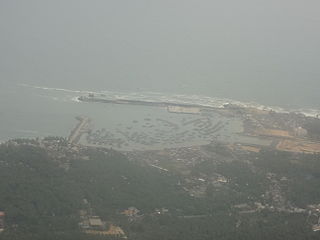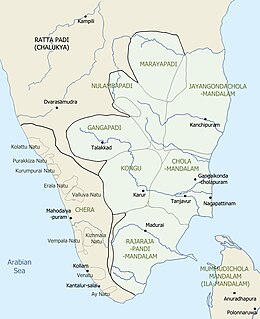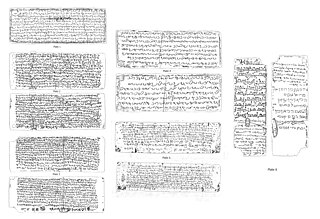 W
WAy dynasty was an Indian ruling lineage which controlled the south-western tip of the peninsula, from the early historic period up to the medieval period. The clan traditionally held sway over the harbour of Vizhinjam, the fertile region of Nanjinad, and southern parts of the spice-producing Western Ghat mountains. The dynasty was also known as Kupaka in medieval period.
 W
WThe battle of Kandalur salai, also spelled Kanthaloor shala, was a naval engagement of the Cholas under Rajaraja I against the "salai" at Kandalur in south Kerala. The exact location of Kandalur—somewhere south Kerala—is a subject of scholarly debate. The above event is sometimes assumed to be identical with the "conquest of Vizhinjam by a general of Rajaraja", before the burning of Lanka, given in the Tiruvalangadu Grant/Plates.
 W
WThe Chera dynasty was one of the principal lineages in the early history of the present day states of Kerala and Tamil Nadu in southern India. Together with the Cholas of Uraiyur and the Pandyas of Madurai, the early Cheras were known as one of the three major powers (muventar) of ancient Tamilakam in the early centuries of the Common Era.
 W
WJewish copper plates of Cochin, also known as Cochin plates of Bhaskara Ravi-varman, is a royal charter issued by the Chera/Perumal king of Kerala, south India to Joseph Rabban, a Jewish merchant magnate of Kodungallur. The charter shows the status and importance of the Jewish colony in Kodungallur (Cranganore) near Cochin.
 W
WKongu Chera dynasty, or Cheras/Keralas of Kongu/Karur, or Veerakeralar, or simply as the Chera/Kerala dynasty, were a medieval royal lineage in south India, initially ruling over western Tamil Nadu and central Kerala. The headquarters of the Kongu Cheras was located at Karur-Vanchi (Karur) in central Tamil Nadu. The Chera rulers of Kongu were subordinate to or conquered by Chalukya, Pallava and Pandya kings. Rashtrakuta and Chola rulers are also said to have overrun the Kongu Chera country.
 W
WKurumathur inscription, also romanised as Kurumattur, is a mid-9th century inscription from Kurumathur, near Areacode in Kerala, south India. The Sanskrit inscription in Pallava Grantha script is engraved on a loose granite slab from the Kurumathoor Vishnu temple. It is one of the rare Sanskrit inscriptions from Kerala.
 W
WKollam/Quilon Syrian copper plates, also known as Kollam Tarisappalli copper plates, or Kottayam inscription of Sthanu Ravi, or Tabula Quilonensis record a royal grant issued by the chieftain of Kollam to a Syrian Christian merchant magnate in Kerala. The royal charter is engraved in old Malayalam in Vattezhuthu on six copper plates. The document is one of the important historical inscriptions of Kerala, the date of which has been accurately determined.
 W
WThiruvalla copper plates, also known as the Huzur Treasury Plates, are a collection of medieval temple committee resolutions found at the Sreevallabha Temple, Thiruvalla, Kerala. The collection of plates, engraved in old Malayalam language in Vattezhuthu with some Grantha characters, can be dated to 10th and 11th centuries AD.
 W
WThomas of Cana copper plates, dated late 8th/early 9th century C.E., are a lost set of copper-plate grants issued by the unidentified Chera/Perumal king of Kerala "Co-qua-rangon" to Christian merchants lead by Knai Thoma in the city of "Makotayar Pattinam", south India. The royal charters were reportedly engraved in Malayalam, Chaldean and Arabic on both sides of two copper plates. Archbishop Francis Ros notes in his 1604 account M.S. ADD 9853 that the plates were taken to Portugal by the Franciscan Order.
 W
WVikramaditya —better known as Vikramaditya "Varaguna"—was a monarch of the Ay dynasty of south India. His surname indicates that he was a vassal or feudatory of the Pandya ruler Varaguna II. He was the immediate successor of Karunantatakkan "Srivallabha", a vassal of Pandya king Srimara Srivallabha.
 W
WVazhappally copper plate is a copper plate inscription in Malayalam language from Vazhappally, in the state of Kerala, south India. It is one of the earliest available epigraphical records mentioning a Chera Perumal ruler of Kerala. Recent scholarship puts the date of the plate in c. 882/83 AD.
 W
WWootz steel is a crucible steel characterized by a pattern of bands and high carbon content. These bands are formed by sheets of microscopic carbides within a tempered martensite or pearlite matrix in higher carbon steel, or by ferrite and pearlite banding in lower carbon steels. It was a pioneering steel alloy invented in Southern India in the mid-1st millenium BC and exported globally.